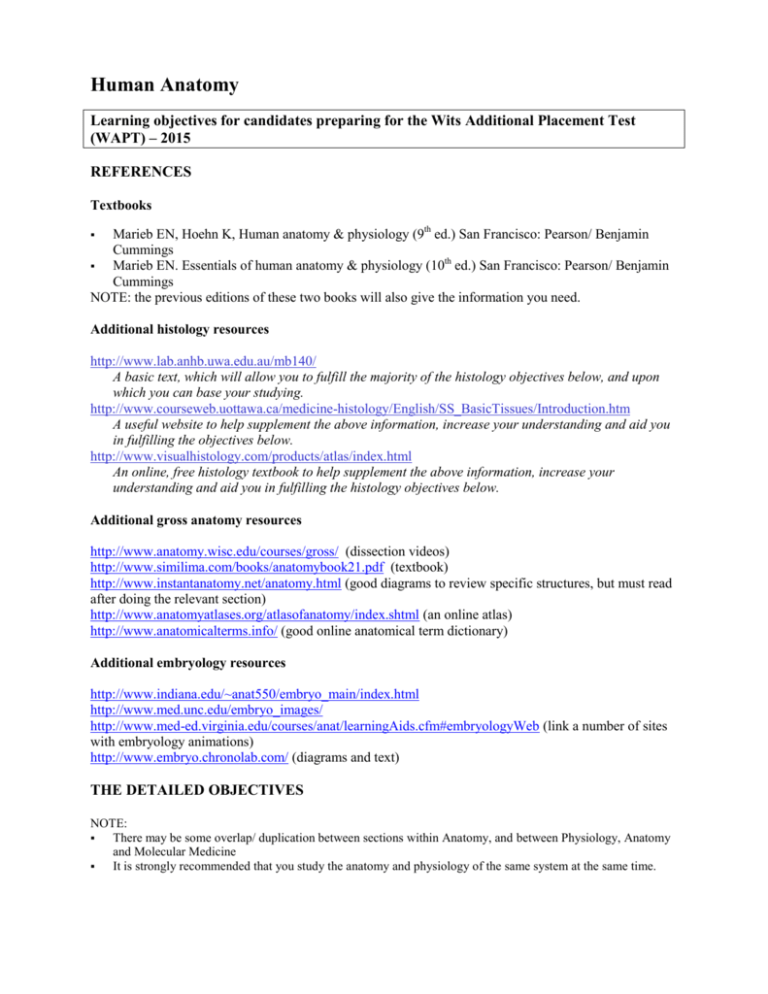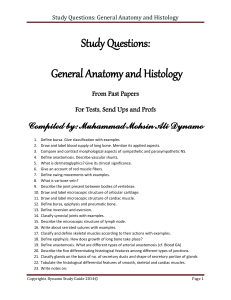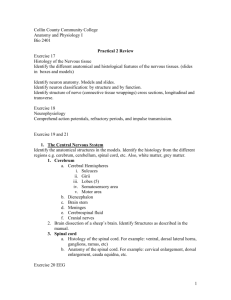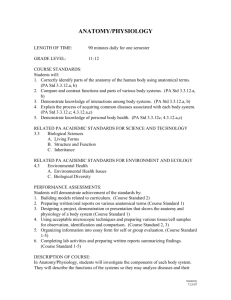WAPT - Human Anatomy
advertisement

Human Anatomy Learning objectives for candidates preparing for the Wits Additional Placement Test (WAPT) – 2015 REFERENCES Textbooks Marieb EN, Hoehn K, Human anatomy & physiology (9th ed.) San Francisco: Pearson/ Benjamin Cummings Marieb EN. Essentials of human anatomy & physiology (10th ed.) San Francisco: Pearson/ Benjamin Cummings NOTE: the previous editions of these two books will also give the information you need. Additional histology resources http://www.lab.anhb.uwa.edu.au/mb140/ A basic text, which will allow you to fulfill the majority of the histology objectives below, and upon which you can base your studying. http://www.courseweb.uottawa.ca/medicine-histology/English/SS_BasicTissues/Introduction.htm A useful website to help supplement the above information, increase your understanding and aid you in fulfilling the objectives below. http://www.visualhistology.com/products/atlas/index.html An online, free histology textbook to help supplement the above information, increase your understanding and aid you in fulfilling the histology objectives below. Additional gross anatomy resources http://www.anatomy.wisc.edu/courses/gross/ (dissection videos) http://www.similima.com/books/anatomybook21.pdf (textbook) http://www.instantanatomy.net/anatomy.html (good diagrams to review specific structures, but must read after doing the relevant section) http://www.anatomyatlases.org/atlasofanatomy/index.shtml (an online atlas) http://www.anatomicalterms.info/ (good online anatomical term dictionary) Additional embryology resources http://www.indiana.edu/~anat550/embryo_main/index.html http://www.med.unc.edu/embryo_images/ http://www.med-ed.virginia.edu/courses/anat/learningAids.cfm#embryologyWeb (link a number of sites with embryology animations) http://www.embryo.chronolab.com/ (diagrams and text) THE DETAILED OBJECTIVES NOTE: There may be some overlap/ duplication between sections within Anatomy, and between Physiology, Anatomy and Molecular Medicine It is strongly recommended that you study the anatomy and physiology of the same system at the same time. Orientation to the Human Body Briefly describe the levels of structural organization in the body Define the meaning of the Latin and Greek terms commonly used to designate body regions Define the different fields of study within the anatomical sciences (embryology, histology and gross anatomy) Define the anatomical terms position and relation, and anatomical planes Compare the dorsal and ventral body cavities in terms of position and contents Describe the subdivisions of the ventral body cavity including their boundaries, contents and further subdivisions and membranes Define the nine regions and four quadrants of the abdomen List the organs located in each abdominal quadrant Cells and Tissues List the special characteristics of epithelium and relate these to function Describe the classification of ‘covering/ lining’ epithelium State the defining histological features of each class of epithelium and relate these features to function Recognise the histologic appearance of basic epithelium types List the differences in structure and function between ‘covering/ lining’ epithelium and ‘glandular epithelium’ Classify the endocrine and exocrine glands in terms of structure and function, and give examples for each class List the components of connective tissue and give the function of each component Classify the basic types of connective tissue according to their components, giving an example of each type Explain how the different structures of the different types of connective tissue relate to their function List the specialized forms of connective tissue (bone and cartilage) and describe the histological classification of each List the histological features of muscle tissue Briefly describe the histological features of the 3 types of muscle tissue Describe the functional unit of muscle at the microscopic level, the sarcomere The Skin Briefly describe the layers of the epidermis (epithelium), dermis (connective tissue) and associated appendages List the major functions of the skin and relate these functions to its histological structure The Skeletal System Classify bones using the gross anatomical classification, giving an example of each type Name the anatomical parts of a long bone Briefly describe the basic types of bone development/growth Describe the microscopic anatomy of bone Describe the bones of the skull Identify the skull foraminae and list the structures passing through each foramen List the bones which form each of the cranial fossae Anterior fossa: frontal, sphenoid; middle fossa: sphenoid, temporal; posterior fossa: temporal, occipital Describe the structure of the vertebral column Describe the general structure of a vertebra and the regional features of cervical, thoracic and lumbar vertebrae and the sacrum Describe the structure and function of an intervertebral disc Define the terms ‘true ribs’ and ‘false ribs’. Describe the features of a typical rib and the sternum Describe the features of the bones of the pectoral girdle, arm and forearm Name the bones of the carpus Describe the bones of the pelvic girdle, thigh and leg Name the bones of the tarsus Describe the arches of the foot, listing the structures important in maintaining each arch The Joints Classify joints using the gross anatomical classification, giving an example of each type Describes the features of a synovial joint Define the anatomical terms of movement Describe the knee, hip, elbow and shoulder using the following headings: classification, articular surfaces, joint capsule, ligaments, movements at the joint, blood and nerve supply, factors aiding stability The Muscular System List the histological features of muscle tissue Briefly describe the histological features of the 3 types of muscle tissue (skeletal, smooth and cardiac muscle) Describe the functional unit of muscle at the microscopic level, the sarcomere List the general functions of muscles and describe how functional muscle groups interact with each other to produce movement Name the muscles of the following regions giving the action and nerve supply of each. Muscles of the head: muscle of mastication Muscles of the anterior neck and throat: suprahyoid muscles, infrahyoid muscles, anterolateral neck muscles Muscles of the vertebral column Muscles of the thorax; superficial muscles of the anterior and posterior thorax The diaphragm Muscles of the abdominal wall Muscles of the pelvic floor and perineum: muscles of the pelvic and urogenital diaphragms. Muscles crossing the shoulder joint Muscles crossing the elbow joint Muscles of the forearm Muscles crossing the hip and knee joints Muscles of the leg Describe the formation of the rectus sheath. The Central and Peripheral Nervous Systems Define the following terms: grey matter, white matter, tract, nerve, nucleus, ganglion, decussation, cortex, central nervous system, peripheral nervous system, autonomic nervous system and somatic nervous system List the components of the central and peripheral nervous systems List the support cells of the nervous system (neuroglia) giving the function of each List the components of a neuron giving the function of each component Classify neurons as per their function and histological structure Describe the process of myelination Describe the ventricular system Name the important sulci, gyri and fissures used to delineate the different lobes of the cerebral hemispheres Describe the topographical organization from the medial to the lateral side of the primary motor and sensory cortex that represent different body areas (motor and sensory homunculi) Describe the position and function of the functional areas of the cerebral cortex Name the subdivisions of the diencephalon, giving the function of each Name the subdivisions of the brainstem, stating the position and function of each Describe the structure and function of the cerebellum Identify the position of the following parts of the brain on images: the cerebral hemispheres, thalamus, hypothalamus, internal capsule, basal nuclei, components of the brainstem, optic chiasm and pituitary gland Name and describe the features of the 3 meningeal layers of the brain and spinal cord Define the term ‘dural venous sinus’ State the formation, circulation and absorption of cerebrospinal fluid Define the blood-brain barrier Describe the longitudinal and cross sectional anatomy of the spinal cord, including the position of the important ascending and descending tracts List the 12 cranial nerves (both by name and roman numeral) and state the major anatomical and functional components of each Describe the cutaneous and motor innervation of the face Describe the formation of a spinal nerve and the general distribution of its rami Name the major plexuses and list the distribution and function of the peripheral nerves arising from each plexus Define the terms dermatome, myotome and nerve plexus Myotome: the muscles innervated by nerve fibres from a particular spinal nerve Define Hilton’s law Classify and list the different types of sensory receptors in the body, and state their location and the stimuli they record List the anatomical differences between the autonomic and somatic nervous systems Describe the anatomy of the parasympathetic and sympathetic divisions of the autonomic nervous system The Special Senses Name the divisions of the ear, and describe the features and give the function of each part Describe the structure of the eyeball and accessory structures of the eye List the elements of the visual pathway State the location of the olfactory epithelium and briefly describe its microscopic features and neurological connections Briefly describe the location and types of taste buds, their microscopic features and their neurological connections The Endocrine System Describe the morphology and anatomy of the hypothalamic-hypophyseal system State the divisions, position, anatomical relations and blood supply of the pituitary, thyroid and adrenal (suprarenal) glands Briefly describe the histological features the pituitary, thyroid and adrenal/ suprarenal glands (cortex and medulla) and the endocrine pancreas Blood NOTE: Blood can also be considered as a specialized form of connective tissue. List the basic cellular components of blood and recognize the basic histological features of the following mature blood cells: red blood cells, neutrophils, macrophages, lymphocytes The Cardiovascular and Lymphatic Systems State the normal anatomical position of the heart and list its important relations Define the term ‘pericardium’ and name the anatomical parts of the pericardium Name the layers of the heart wall Name the chambers of the heart and the great vessels associated with each chamber Describe the pulmonary and systemic circulations Describe the coronary circulation including the origin, course and branches/ tributaries of the blood vessels Name the heart valves and describe their location List the histological features of cardiac muscle and relate these to function Describe the conducting system of the heart by listing the structures through which an electrical impulse passes List the three layers which form the wall of a blood vessel and give the function of each layer Compare the structure of the walls of elastic arteries, muscular arteries, arterioles, capillaries, venules and veins and relate any differences to function List, in order, major branches of the aorta and the superior and inferior vena cava Describe the arterial supply and venous drainage of the following regions: The head and neck (including the brain) The upper limb and thorax The abdomen (name the artery which supplies each organ) The lower limb Describe the formation of the portal vein List the components of the lymphatic system and state their functions List the two main lymphatic vessels, describe their course and state their drainage areas Describe the microscopic structure of a typical lymph gland List the main groups of lymph nodes in the body Briefly describe the location and structure of the spleen, thymus and mucosa-associated lymphatic tissue (MALT) The Respiratory System Name the organs forming the respiratory passageway(s) Describe the location and function of the nose, paranasal sinuses, pharynx and larynx Describe the gross anatomical features of the trachea, bronchi, lungs and pleura List, in order, the divisions of the tracheobronchial tree Describe the blood supply and innervation of the lungs Describe the histological features of the trachea and alveolus Describe the structural (histological) changes which occur from the trachea to the alveoli and relate these changes to changes in function List the components of the blood gas barrier The Digestive System Define the terms parietal peritoneum, visceral peritoneum, mesentery, lesser omentum and greater omentum, intraperitoneal and retroperitoneal Describe the general histological structure of the alimentary canal List the gross anatomical features of the oesophagus, stomach, liver and biliary tree, pancreas, small intestine and large intestine, including the appendix List the histological features of the oesophagus, stomach, small and large intestine noting differences between the different regions of these organs and relate these differences to function Describe the histology of a liver lobule List the histological features of the exocrine pancreas Briefly describe the number, types and microscopic features of the 2 sets of teeth Briefly describe the types, sites and secretions of the salivary glands The Urinary System Name the components of the urinary system Describe the gross anatomy of the kidney and its coverings Describe the histological arrangement of the functional unit of the kidney, the nephron Describe the location and structure of the ureter, urinary bladder and urethra List the histological features of the ureters and bladder The Reproductive System Describe the location and structure of the testes, penis, epididymis, ductus deferens, ejaculatory duct, seminal vesicles and prostate gland Describe the location and structure of the ovaries, uterine tubes, uterus and vagina Name the components of the female external genitalia Describe the histology of the ovary and endometrium with reference to the changes that occur during the female reproductive cycle Embryology Define the terms cleavage, morula, blastocyst, trophoblast and inner cell mass Name the derivatives of the trophoblast and embryonic disc Describe placenta formation and list the functions of the placenta Describe the process of gastrulation and list the structures formed by the three primary germ layers Describe the process of neuralation Describe the fetal circulation While these are the examinable objectives for embryology, it is recommended that the entire section in Human anatomy & physiology (Marieb EN, Hoehn K) is studied to gain complete understanding.








